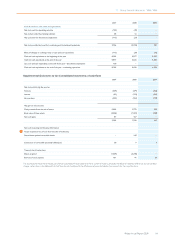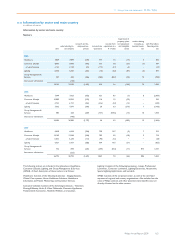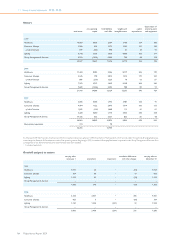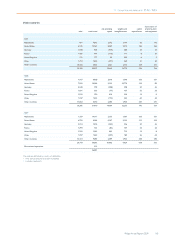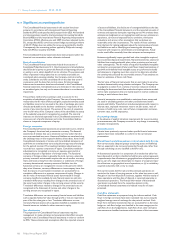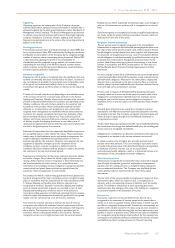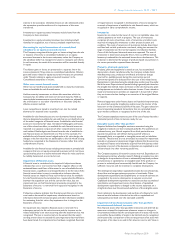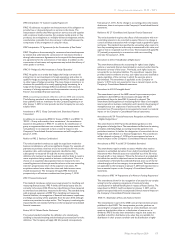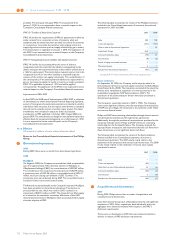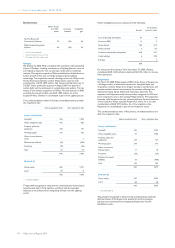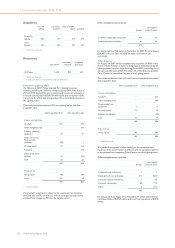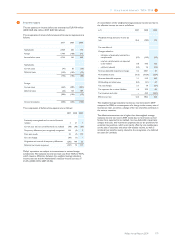Philips 2009 Annual Report Download - page 169
Download and view the complete annual report
Please find page 169 of the 2009 Philips annual report below. You can navigate through the pages in the report by either clicking on the pages listed below, or by using the keyword search tool below to find specific information within the annual report.
interest in the associates. Unrealized losses are also eliminated unless
the transaction provides evidence of an impairment of the asset
transferred.
Investments in equity-accounted investees include loans from the
Company to these investees.
Investments in equity-accounted investees also include goodwill
identified on acquisition, net of any accumulated impairment loss.
Accounting for capital transactions of a consolidated
subsidiary or an equity-accounted investee
The Company recognizes dilution gains or losses arising from the sale
or issuance of stock by a consolidated subsidiary or an equity-
accounted investee in the income statement, unless the Company or
the subsidiary either has reacquired or plans to reacquire such shares.
In such instances, the result of the transaction will be recorded directly
in equity.
The dilution gains or losses are presented in a separate line in the
income statement if they relate to consolidated subsidiaries. Dilution
gains and losses related to equity-accounted investees are presented
under ‘Results relating to equity-accounted investees’ in the
Consolidated statements of income.
Other non-current financial assets
Other non-current financial assets include held-to-maturity investment,
loans and available-for-sale financial assets.
Held-to-maturity investments are those debt securities which the
Company has the ability and intent to hold until maturity. Held-to-
maturity debt investments are recorded at amortized cost, adjusted for
the amortization or accretion of premiums or discounts using the
effective interest method.
Loans receivable are stated at amortized cost, less the related
allowance for impaired loans receivable.
Available-for-sale financial assets are non-derivatives financial assets
that are designated as available-for-sale and that are not classified in any
of the other categories of financial assets. Available-for-sale financial
assets are recorded at fair value. Unrealized holding gains and losses,
net of the related tax effect, on available-for-sale financial assets are
reported as a separate component of other comprehensive income
until realized. Realized gains and losses from the sale of available-for-
sale financial assets are determined on a first-in, first-out basis. For
available-for-sale financial assets hedged under a fair value hedge, the
changes in the fair value that are attributable to the risk which is being
hedged are recognized in the Statement of income rather than other
comprehensive income.
Available-for-sale financial assets including investments in privately held
companies that are not equity-accounted investees, and do not have a
quoted market price in an active market and whose fair value could not
be reliably determined, are carried at cost.
Impairment of financial assets
A financial asset is considered to be impaired if objective evidence
indicates that one or more events have had a negative effect on the
estimated future cash flows of that asset. In case of available-for-sale
financial assets, a significant or prolonged decline in the fair value of the
financial assets below its cost is considered an indicator that the
financial assets are impaired. If any such evidence exists for available-
for-sale financial assets, the cumulative loss - measured as the difference
between the acquisition cost and the current fair value, less any
impairment loss on that financial asset previously recognized in the
Statement of income - is removed from equity and recognized in the
Statement of income.
If objective evidence indicates that financial assets that are carried at
cost need to be tested for impairment, calculations are based on
information derived from business plans and other information available
for estimating their fair value. Any impairment loss is charged to the
Statement of income.
An impairment loss related to financial assets is reversed if in a
subsequent period, the fair value increases and the increase can be
related objectively to an event occurring after the impairment loss was
recognized. The loss is reversed only to the extent that the asset’s
carrying amount does not exceed the carrying amount that would have
been determined, if no impairment loss had been recognized. Reversals
of impairment are recognized in the Statement of income except for
reversals of impairment of available-for-sale financial assets, which are
recognized in other comprehensive income.
Inventories
Inventories are stated at the lower of cost or net realizable value, less
advance payments on work in progress. The cost of inventories
comprises all costs of purchase, costs of conversion and other costs
incurred in bringing the inventories to their present location and
condition. The costs of conversion of inventories include direct labor
and fixed and variable production overheads, taking into account the
stage of completion and the normal capacity of production facilities.
Costs of idle facility and abnormal waste are expensed. The cost of
inventories is determined using the first-in, first-out (FIFO) method.
Inventory is reduced for the estimated losses due to obsolescence. This
reduction is determined for groups of products based on purchases in
the recent past and/or expected future demand.
Property, plant and equipment
Property, plant and equipment is stated at cost, less accumulated
depreciation. Assets manufactured by the Company include direct
manufacturing costs, production overheads and interest charges
incurred for qualifying assets during the construction period.
Government grants are deducted from the cost of the related asset.
Depreciation is calculated using the straight-line method over the useful
life of the asset. Depreciation of special tooling is generally also based on
the straight-line method. Gains and losses on the sale of property, plant
and equipment are included in other business income. Costs related to
repair and maintenance activities are expensed in the period in which
they are incurred unless leading to an extension of the original lifetime
or capacity.
Plant and equipment under finance leases and leasehold improvements
are amortized using the straight-line method over the shorter of the
lease term or the estimated useful life of the asset. The gain realized on
sale and operating leaseback transactions that are concluded based
upon market conditions is recognized at the time of the sale.
The Company capitalizes interest as part of the cost of assets that take a
substantial period of time to become ready for use.
Intangible assets other than goodwill
Acquired definite-lived intangible assets are amortized using the
straight-line method over their estimated useful life. The useful lives are
evaluated every year. Brands acquired from third parties that are
expected to generate cash inflows during a period without a
foreseeable limit, are regarded as intangible assets with an indefinite
useful life. These brands are not amortized, but tested for impairment
annually or whenever an impairment trigger indicates that the asset may
be impaired. Patents and trademarks acquired from third parties either
separately or as part of the business combination are capitalized at cost
and amortized over their remaining useful lives.
The Company expenses all research costs as incurred. Expenditure on
development activities, whereby research findings are applied to a plan
or design for the production of new or substantially improved products
and processes, is capitalized as an intangible asset if the product or
process is technically and commercially feasible and the Company has
sufficient resources and the intention to complete development.
The development expenditure capitalized includes the cost of materials,
direct labor and an appropriate proportion of overheads. Other
development expenditures and expenditures on research activities are
recognized in the income statement as an expense as incurred.
Capitalized development expenditure is stated at cost less accumulated
amortization and impairment losses. Amortization of capitalized
development expenditure is charged to the income statement on a
straight-line basis over the estimated useful lives of the intangible assets.
Costs relating to the development and purchase of software for both
internal use and software intended to be sold are capitalized and
subsequently amortized over the estimated useful life.
Impairment of non-financial assets other than goodwill,
inventories and deferred tax assets
Non-financial assets other than goodwill, inventories and deferred tax
assets are reviewed for impairment whenever events or changes in
circumstances indicate that the carrying amount of an asset may not be
recoverable. Recoverability of assets to be held and used is recognized
and measured by a comparison of the carrying amount of an asset with
the greater of its value in use and its fair value less cost to sell. Value in
11 Group financial statements 11.11 - 11.11
Philips Annual Report 2009 169




